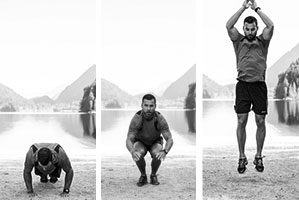
Do you have trouble making time for fitness? High intensity interval training, or HIIT, could be the answer. It's fast-paced, fun, and time efficient.
Less time on the treadmill with greater health and fitness results? It may sound too good to be true, but according to recent research studies, less is more when it comes to workouts that are based on high intensity interval training (HIIT).
Can workouts be time efficient—and beneficial?
When you have a busy schedule, errands to run, and multiple activities on the go, getting in a workout needs to be time efficient. Not only that, but spending 60-plus minutes plugging away on a stationary gym machine can get boring fast; your workout should be fun and motivating to keep you coming back for more.
High intensity interval training is a fun and innovative way to work out at the gym or home. Not the usual two sets of 15 and move to the next one, HIIT involves instead a series of high intensity, short bursts of exercise followed by a recovery phase. Any kind of cardiovascular or strength exercise will do the trick, as long it’s intense.
So why HIIT over another type of training? Besides being fast paced and fun, HIIT has been shown in studies to
- oxidize (burn) fat at a higher rate, as well as lower carbohydrate burning after six weeks
- increase VO2 max (the body’s upper limit for consuming, distributing, and using oxygen for energy production)
- increase the size and number of mitochondria, our cells’ power producers (important for giving you more energy and greater endurance)
- increase skeletal muscle
- induce excess post-exercise oxygen consumption (EPOC)—elevated oxygen consumption, thus calorie expenditure equals longer calorie burn following exercise
What is HIIT?
HIIT is essentially interval training; a style of training that has been used by athletes for many years to train for sports and conditioning. A HIIT program consists of sessions that incorporate periods of exertion alternating with periods of rest or lighter exertion.
With HIIT, these intervals are done at an exertion level of seven or more (out of 10), usually for 30 seconds to 3 minutes, but can be done for shorter or longer periods of time as well.
Recovery intervals, which are essential, are longer than the exertion intervals.
What are the benefits of HIIT?
Overall, HIIT provides better endurance, higher levels of fat loss, and better overall physical fitness from working out smarter, not harder.
It’s efficient—and portable
Not needing as much time as a traditional workout to get the same results, HIIT can be done in as little as 18 to 26 minutes. A study done at McMaster University has shown that within this time frame, six sessions of eight to 12 60-second constant intervals results in “… significant improvements in functional exercise performance and skeletal muscle mitochondrial biogenesis [forming].”
Improved insulin action
As well as having the benefits of being quick and portable, this type of workout can also improve insulin action, reducing metabolic risk factors in people who might otherwise not stick to a program that follows longer time frames, according to a UK study. This is great news for new gym goers who don’t want to spend too much time on cardio equipment.
Improved cardio function
For people with cardiovascular disease, HIIT can be a great way to improve cardiovascular function and increase VO2 max; they get the results in a shorter time frame with fewer sessions. People who participated in an eight-week UK study increased their VO2 max by 15 percent compared to continuous training program participants, who increased theirs by 9 percent.
Better weight management
The EPOC effect—oxygen consumption following exercise—remains elevated after a HIIT workout; this means a higher and longer calorie burn, even when you’re out shopping or having a coffee.
All ages can benefit
HIIT is not just for athletes or youth; older and less fit people are just as capable of engaging in this type of training and seeing results.
The McMaster University study was specifically designed to test the benefits of HIIT for the general population. Their conclusion: “Together, the results demonstrate that a practical low-volume HIIT programme is effective for improving muscle metabolic capacity and functional performance.”
HIIT at home or gym
With different workout goals in mind, you may want to do more cardio-based or strength-based exercises.
In the McMaster University study, subjects trained on bikes, warming up for three minutes before engaging in 60-second work intervals followed by 75 seconds of recovery, cycling at a lower rate.
At the gym, this could be done on a spin bike, treadmill, stair climber, or rowing machine.
HIIT exercises
Getting into a routine using the HIIT principles is easy; you only need a few exercises, and you can use little or no equipment. The following routine can be done at the gym or at home.
Before beginning, be sure to warm up for 5 to 6 minutes doing light aerobic work, by walking, jogging, rowing, or using an elliptical machine. Follow that up with a set of 15 each of arm circles, shoulder shrugs, and knee raises to get your joints limber and ready for exercise.
Never begin a HIIT workout, or any workout for that matter, without warming up first.
If you have health concerns or are pregnant or breastfeeding, see your health care practitioner before starting any exercise program.
Do each exercise for 30 seconds, followed by a 45-second recovery of walking or side-to-side steps.
Each exercise can be modified to make it easier if you’re just starting out or have any joint issues that need a more gentle exercise.
Jumping Jack with Tuck—a total body exercise

Start in a standing position, and do a regular jumping jack. On your way back, tuck down to the floor, bending your knees, and put your hands on the floor in front of you. Burst back up into a regular jack position with feet out wide and hands over head. Repeat.
Modification: Don’t tuck.
Squat Jumps—a butt and leg exercise

Stand with your feet out wide, toes turned forward. Sit back into a squat position as deep as you can, then burst back up swinging your arms in front of you; reach for the sky. Land back into a squat with your knees bent. Repeat.
Modification: Don’t jump.
Burpees—a total body exercise

Start by standing up with your hands over your head. Quickly jump up and thrust yourself down, getting into a plank position. Jump your knees back up toward your chest, and push your body quickly back up to starting position, jumping up and swinging your arms to the ceiling. Repeat.
Modification: Don’t jump.
Scissor Jumps—a leg and butt exercise

Start in a split stance with one leg behind the other, bend both knees. Quickly switch your legs from front to back like scissors opening. Land with bent knees each time you switch legs, and swing your arms beside you strongly. Repeat.
Modification: Tap your foot behind you instead of jumping.
Mountain Climbers—a core and cardio exercise

Start in a push-up position with your hands under your shoulders and your feet out behind you, flat back and stomach held in tight. Pull one knee toward your chest, then alternate with your other leg. Continue switching legs, adding some speed as if you’re running in push-up position.
Modification: Go slowly.
HIIT is versatile, fun and keeps you out of breath; a great feeling when you only have 20 to 30 minutes to exercise. Studies have repeatedly shown that this type of training will give you the same results, if not better than, longer cardio workouts.
So why not do your own hands-on research and find out for yourself what HIIT has to offer for your health and fitness? You won’t be disappointed.




